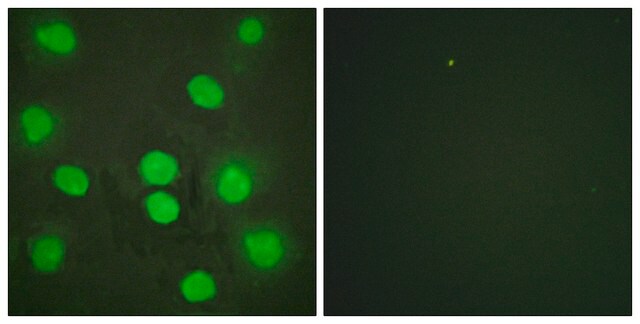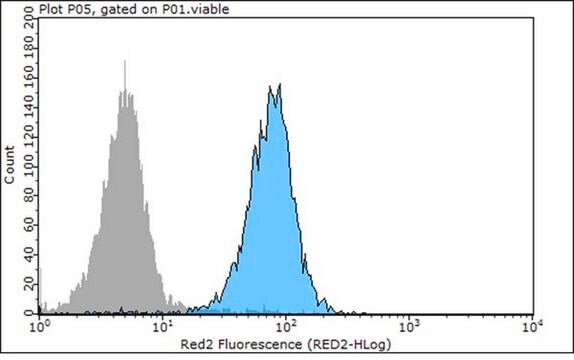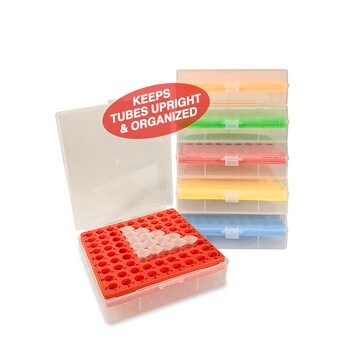一般說明
We are committed to bringing you greener alternative products, which adhere to one or more of The 12 Principles of Green Chemistry.This antibody is Preservative-free, produced without the harm or sacrifice of animals and exceptionally stable to allow for ambient shipping and storage if needed and thus aligns with "Waste Prevention", "Designing Safer Chemicals" and "Design for Energy Efficiency".
Click here for more information.
ZooMAb® antibodies represent an entirely new generation of recombinant monoclonal antibodies. Each ZooMAb® antibody is manufactured using our proprietary recombinant expression system, purified to homogeneity, and precisely dispensed to produce robust and highly reproducible lot-to-lot consistency. Only top-performing clones are released for use by researchers. Each antibody is validated for high specificity and affinity across multiple applications, including its most commonly used application. ZooMAb® antibodies are reliably available and ready to ship when you need them.
特異性
Clone 1K15 is a ZooMAb® rabbit recombinant monoclonal antibody that specifically detects GATA4. It targets an epitope within 23 amino acids from the C-terminal region.
免疫原
KLH-conjugated linear peptide corresponding to 23 amino acids from the C-terminal region of human GATA4.
應用
Quality Control Testing
Evaluated by Western Blotting in HEK293 cell lysate.
Western Blotting Analysis: A 1:1,000 dilution of this antibody detected GATA4 in HEK293 cell lysate.
Tested Applications
Western Blotting Analysis: A 1:1,000 dilution from a representative lot detected GATA4 in lysates from U2OS, NIH3T3, and PC12 cells and His/T7-tagged recombinant fragment of Human GATA4.
Immunocytochemistry Analysis: A 1:1,000 dilution from a representative lot detected GATA4 in HepG2 cells.
Immunohistochemistry (Paraffin) Analysis: A 1:100 dilution from a representative lot detected GATA4 in Human testis tissue sections.
Flow Cytometry Analysis: 0.1 µg from a representative lot detected GATA4 in one million U2OS cells.
Affinity Binding Assay: A representative lot of this antibody bound GATA-4 peptide with a KD of 7.3 x 10-9 in an affinity binding assay.
Note: Actual optimal working dilutions must be determined by end user as specimens, and experimental conditions may vary with the end user.
標靶描述
Transcription factor GATA-4 (UniProt: P43694; also known as GATA-binding factor 4) is encoded by the GATA4 gene (Gene ID: 2626) in human. The GATA family has six members that are divided into two subfamilies based on sequence similarity and expression profiles. GATA-1, -2, and -3 are expressed in hematopoietic cells and are involved in regulating proliferation and differentiation of blood cells and GATA-4, -5, and -6 are expressed in cardiac tissue. GATA-4 is a member of the highly conserved zinc-finger transcription factors with two GATA-type zinc fingers (aa 217-241 and 271-295) and plays a critical role in regulating differentiation, growth, and survival of a wide range of cell types. It binds to the consensus sequence 5′-AGATAG-3′ and plays a key role in cardiac development and function. In cooperation with T-Box Transcription Factor 5 (TBX5), it binds to cardiac super-enhancers and promotes cardiomyocyte gene expression, while it down-regulates endocardial and endothelial gene expression. It is also shown to be essential for normal testicular development. Higher expression of GATA-4 is observed the throughout embryonic development and postnatal growth. It functions as a critical regulator of cardiac differentiation. It is reported to function as a regulator of various cardiac genes, such as ANP, BNP, α-MHC, and β-MHC. Depletion of GATA-4 is shown to downregulate the expression of cardio regulators. Mutations in GATA4 gene are reported to cause Atrial septal defect 2 (ASD2) and ventricular septal defect 1 (VSD1) that are associated with defects in the cardiac conduction system and congenital cardiovascular anomalies. Gata4 knockout mouse embryos display septation defects, hypoplastic ventricular myocardium, and disrupted cardiac looping. Two isoforms of GATA-4 have been described that are produced by alternative splicing. This ZooMAb recombinant monoclonal antibody, generated by our proprietary technology, offers significantly enhanced specificity, affinity, reproducibility, and stability over conventional monoclonal. (Ref.: Ang, Y-S., et al. (2016). Cell. 167(7); 1734-1749; Xu, M., et al. (2012). Prog. Mol. Biol. Transl. Sci. 111; 217-241; Lourenco, D., et al., (2011). Proc. Natl. Acad. Sci. USA. 108(4); 1597-1602).
外觀
Purified recombinant rabbit monoclonal antibody IgG, lyophilized in PBS with 5% Trehalose, normal appearance a coarse or translucent resin. The PBS/trehalose components in the ZooMAb formulation can have the appearance of a semi-solid (bead like gel) after lyophilization. This is a normal phenomenon. Please follow the recommended reconstitution procedure in the data sheet to dissolve the semi-solid, bead-like, gel-appearing material. The resulting antibody solution is completely stable and functional as proven by full functional testing. Contains no biocide or preservatives, such as azide, or any animal by-products. Larger pack sizes provided as multiples of 25 µL.
重構
300 µg/mL after reconstitution at 25 µL per vial. Please refer to guidance on suggested starting dilutions and/or titers per application and sample type.
儲存和穩定性
Recommend storage of lyophilized product at 2-8°C; Before reconstitution, micro-centrifuge vials briefly to spin down material to bottom of the vial; Reconstitute each vial by adding 25 µL of filtered lab grade water or PBS; Reconstituted antibodies can be stored at 2-8°C, or -20°C for long term storage. Avoid repeated freeze-thaws.
法律資訊
ZooMAb is a registered trademark of Merck KGaA, Darmstadt, Germany
免責聲明
Unless otherwise stated in our catalog or other company documentation accompanying the product(s), our products are intended for research use only and are not to be used for any other purpose, which includes but is not limited to, unauthorized commercial uses, in vitro diagnostic uses, ex vivo or in vivo therapeutic uses or any type of consumption or application to humans or animals.






